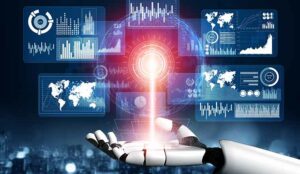Talkdesk’s Jay Gupta decodes the fiction and explores the myths of artificial intelligence.
Critically Evaluating the Most Common AI Assumptions
The artificial intelligence revolution is moving full speed ahead, transforming business operations across industries, yet three assumptions always seem to make their way into conversations about AI.
Talkdesk partnered with Paige Lord, AI ethicist and TikTok influencer, to analyze common AI assumptions and explain what is true and what is myth.
As an expert in AI ethics, Paige Lord studies AI and technology to raise concerns, reduce coded bias, and increase AI awareness.
Creators and users of AI-powered technology are encouraged to uncover and evaluate the potential harms AI might bring to the world and help mitigate those risks.
Amid so many conversations about the AI revolution, it’s a great time to look through an AI ethics lens. Critically evaluate common misconceptions about AI to gain deeper insight into how it can be used to create memorable customer experiences.
The Myths of Artificial Intelligence.
Let’s dive into the three most common AI assumptions.
1. The Robot Apocalypse Is Imminent.
One of the most common misconceptions about AI is that robots are going to take over the world in a hostile fashion.
To critically evaluate this, we must explore the context of the question and determine whether it would be technically feasible for this to happen in the first place.
Exploring the Context.
While the terms AI and robots are often used interchangeably, these technologies can actually operate independently or interdependently.
Artificial intelligence is a branch of computer science. Robotics is a branch of artificial intelligence. There can be robots that leverage AI and there can be robots that are automated without the use of AI.
It’s true that AI technology is rapidly spreading around the world and fueling conversations about what’s next.
At the same time, automated machines have been widely used since the third industrial revolution. In many ways, simple robots have already taken over our world through digital mediums and this is just the next step in the progression of industries.
Determining Whether It’s Technically Feasible.
A great way to quickly debunk one of the myths of artificial intelligence that robots might take over the world in a hostile fashion is to consider Moravec’s Paradox.
Hans Moravec, a pioneer and leading thinker in robotics, recognized a simple paradox: tasks that are simple for humans are complex for robots to perform and tasks that are simple for robots are complex for humans to perform.
For example, it’s easy for a robot or AI to do complex mathematics quickly. Complex mathematics is challenging for most humans. Meanwhile, it’s incredibly difficult for a robot or AI to jump from one platform to another or pick up a coin from a table.
Conversations about AI often boil down to empathy versus efficiency. Bots aren’t great at tapping into emotional empathy the way that humans are. However, a bot will almost certainly be faster and better at estimating shipping time or costs. There’s a clear distinction.
Yes, robots are becoming more advanced. Products like Roomba and drones have become commonplace, but the complex technological advances required for a robot to operate independently of an operator or its code are out of reach at the moment.
Autonomous robots would require a complex set of neural networks that take in information, interpret that information, make an autonomous decision with the information, and then act on the decision.
In acting on the decision, it would have to possess the mechanical dexterity to move with intention and enthusiasm. The robot would have to overcome multiple parameters to become a thinking, moving robot controlled by its mind.
There are three categories of AI: artificial narrow intelligence (ANI), artificial general intelligence (AGI), and artificial super-intelligence (ASI).
To date, the technology hasn’t moved past the first category, artificial narrow intelligence. A robot takeover would require ASI, and technically we’re just not there.
2. AI Can Do Anything.
AI is advancing and it’s useful for so many purposes, but there are limits to what it can and should do because it lacks consciousness.
AI can mimic talking, seeing, hearing, smelling, and even thinking, but when a bot says that it understands a customer’s frustration, it actually doesn’t. AI lacks the capacity to feel positive or negative emotions; actually, it doesn’t feel anything at all.
On the other hand, human beings are capable of taking knowledge and coming up with their own original thoughts. AI is really good at collecting data and firing back information.
The first chatbot ever created was called “The Doctor” because it would ask people about their problems, just like a therapist, but technology can’t understand how a human actually feels.
Humans require doctors that have empathy, compassion, and humanity, all qualities AI simply doesn’t have. AI can do a great many things, but it can’t be human.
We must keep this critical truth in mind whenever we explore the amazing capabilities and possibilities of artificial intelligence for businesses.
3. AI Can’t Possibly Be Good.
Artificial intelligence has grown from an experimental field to an applied field that offers solutions to increase efficiency, reduce business costs, and increase customer satisfaction, every single day.
In the medical field, institutions are using computer vision and anomaly detection to scan for cancer and other medical concerns. Doctors review these scans, but AI helps detect issues that doctors may not notice.
City governments in the U.S. are using computer vision to scan dumpsters to see how full they are and to identify any items that should not be placed in the dumpsters.
This data is then combined with AI to optimize daily routes, which reduces noise and air pollution and drives down municipal costs. Now, collectors only stop where pickups are required and taxpayer dollars can be reallocated to other areas.
AI is also used in every industry to increase customer satisfaction and reduce customer frustration. The world is increasingly connected through digital channels and when a customer has a bad experience with a retailer or a tech company, they’re likely to tell their friends, write a comment on social media, and reach out to the company directly.
Companies can use AI sentiment analysis to understand the level of a customer’s frustration and provide feedback to the business so they can step in to quickly correct processes and make things right.
AI can track messages a company receives and the tone in which the message is shared. Sentiment analysis has proven to be a game changer because with this level of customer insight, companies are in a better position to improve customer satisfaction and build trust through every interaction.
Looking Forward to AI-Powered Customer Experience Success.
It’s an exciting time to be a part of the AI revolution. The use cases are endless and so is the CX potential. Going forward, it’s important to keep in mind Paige Lord’s advice, “The key to creating AI is keeping humans-in-the-loop by always having the work and results of AI reviewed by a human.”
Artificial intelligence has necessary and important limits and it’s wise to stay curious and cautious when talking about and working with AI.
This blog post has been re-published by kind permission of Talkdesk – View the Original Article
For more information about Talkdesk - visit the Talkdesk Website
Call Centre Helper is not responsible for the content of these guest blog posts. The opinions expressed in this article are those of the author, and do not necessarily reflect those of Call Centre Helper.
Author: Talkdesk
Published On: 6th Apr 2023 - Last modified: 23rd Apr 2024
Read more about - Guest Blogs, Jay Gupta, Talkdesk






 Talkdesk is a global customer experience leader for customer-obsessed companies. Our contact center solution provides a better way for businesses and customers to engage with one another.
Talkdesk is a global customer experience leader for customer-obsessed companies. Our contact center solution provides a better way for businesses and customers to engage with one another. 

































